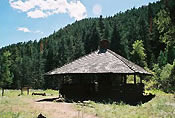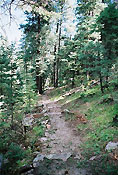National and State Register
Squirrel Creek Recreational Unit
Custer County
Located 26 miles southwest of Pueblo in Pueblo and Custer counties, the Squirrel Creek Recreational Unit consists of a four-mile segment of a historic road (now known as Squirrel Creek Trail) that parallels much of Squirrel Creek.
The road connects with the other resources in the district, including the Squirrel Creek Campground with its picnic shelter; the Cascade Trail; and the ruins of the Squirrel Creek Lodge. Improvements began in 1919 and the area remained in use until 1947, when a flash flood destroyed much of the road, part of the trail, and portions of the campground. The recreational property is associated with the rapid growth and development of outdoor recreation in the United States following World War I.
The district exemplifies the post-war transition of the Forest Service from a focus on timber and watershed management to a new role in public outdoor recreation. Construction began as a result of promotional and financial assistance from the nonprofit local cooperative association, the San Isabel Public Recreation Association. Arthur Carhart, the first full-time landscape architect hired by the USFS, is credited with the application of integrated recreational planning in the National Forests. During his tenure with the Forest Service (from 1919 through 1922), Carhart developed the first forest-wide comprehensive recreational plan that was later used as a model throughout the National Forest system. As the first professionally and comprehensively planned recreation complex in the National Forest system, the Squirrel Creek Recreational Unit is nationally significant.


